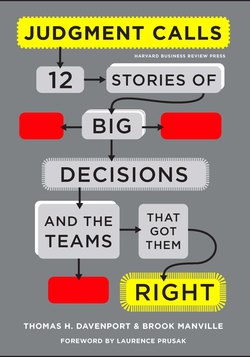Читать книгу Judgment Calls - Thomas H. Davenport - Страница 21
На сайте Литреса книга снята с продажи.
The Persistence of Good Judgment
ОглавлениеSeveral elements of the process used to analyze, delay, and eventually approve the launch contributed to NASA's good judgment. Overriding all was the design of an FRR problem-solving process, which brought together so many and varied experts and interested parties in one room and also through a series of well-orchestrated offline working sessions. Discussions were artfully facilitated so stakeholders could listen to one another and discuss their findings and opinions in a “truth first, hierarchy later” kind of way. Widespread, “democratic” polling (rather than, say, providing information to a few senior managers who would make the decision themselves) was another hallmark of the process. The FRR designed into the process the presence and influence of multiple viewpoints and sets of expertise—an important component of judgment, and one that study after study has shown to be critical to successful decision making.5
The extent and quality of testing and research, including having separate groups take different approaches to the same problem, were also important. The scientific culture of NASA, and its commitment to having the best possible factual information, was another critical aspect.
Understanding the importance and potential consequences of a decision—in this case, seeing the astronauts whose lives depend on the shuttle technology and, at the same time, understanding the legitimate need to fly as soon as it is possible to do so safely—was a living example of another invaluable dimension of building judgment into this process: tightly linking the stakes of the decision to the accountability for what would be decided.
The leader's approach and style in managing this entire process was also fundamental.6 Decision-making processes are often subverted by a leader who pays lip service to consultation, going through the motions of openness while pushing the group toward the choice he's already made. Similarly, some attempts to create a decision-making process fail because they go to the opposite extreme—encouraging endless discussion and lowest-common-denominator consensus building.
NASA colleagues praised Gerstenmaier's openness to discussion and debate while still keeping his eye on the need to find the best possible answer in the context of project constraints. Several of the participants in the FRRs commented generally on how NASA's culture has been changed, learning from the tragedies that came before—away from “launch fever” and much more balanced toward safety; away from discouraging or disregarding dissent from engineers and others, but rather embracing scientific inquiry as a critical partner in final decision making.
The earlier, fatal errors in the shuttle program happened in part because of the agency's tendency to think of space flight as routine—operational rather than experimental—when it in fact remains a risky endeavor that tests the limits of complex technology designed to control immense forces. Gerstenmaier notes that the probability of failure of a shuttle mission with no obvious technical problems is about 1 in 77—not odds that any of us would accept in commercial aviation. In “Some Safety Lessons Learned,” Bryan O'Conner writes about the importance and difficulty of fighting complacency:
Countering complacency is arguably harder than recovering from a mishap. We have to find creative ways to counteract the common psychological tendency to assume that a string of successes means that we have somehow reached a state of engineering and operational perfection—and, therefore, immunity from failure.7
Sustaining a commitment to safety—and to good judgment—requires constant, vigilant attention to both processes and culture. It also requires what writer Edmund Gosse long ago described as “higher modesty”—the recognition that, no matter how smart and knowledgeable you are, you can still be thoroughly wrong about important issues.8
